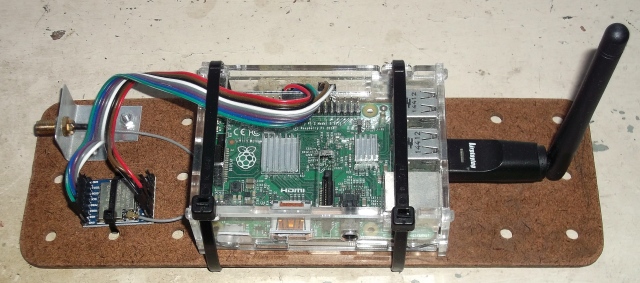
Having read in 2023 that some of the UK Summits On The Air fraternity were experimenting with low-power "Internet of Things" hardware to operate APRS on 70cm, I decided to give it a try for myself. This system had been slow to catch on in the UK compared with mainland Europe, but I was already familiar with LoRa hardware (as used by the UK High Altitude Society to track their balloon experiments up to the stratosphere and back on 434MHz) and I had a spare TTGO board which I could program as a temporary receive IGate (G6GVI-10). Thus I only needed a buy a TTGO T-Beam unit to program as my G6GVI-11 portable tracker.
The T-Beam is a compact board which includes GNSS navigation, LoRa radio, an OLED display and even has a battery holder for an 18650 Lithium-ion battery on the back. I put the unit into a small plastic case (which I can fasten onto the shoulder-strap of my rucsack) and fitted a flexible quarter-wave antenna. This improvised case has protected it well for more than a year, even surviving a 2m drop onto concrete!

One of my first tests was a walk around the local park, which gave excellent coverage with <100mW on 439MHz.
But when I took the unit up onto the local moors (Winter Hill), I was delighted to find that its range extended tens of miles down to well-sited IGates in Oswestry, Shrewsbury, Welshpool, and even Powys!

Now I take this little tracker with me whenever I go up on the hills, so that the stations with whom I'm talking on 23cm or 4m can see whereabouts I am on the hill.
Interest in LoRa APRS grew considerably during the year, as many more IGates were established around the UK:

I'd found a project from Austria which provided a simple conversion of one of my existing LoRa receivers into an APRS IGate, with which I could fill in the local coverage on my way up to the moors, before the more distant stations could track me:


However, in July 2024 I discovered that my IGate was no longer uploading correctly: this seemed to be due to a change in the APRS-IS filters, but I quickly devised a fix (adding one line into the original Python code to remove the RSSI & SNR elements):

In September 2024, I built yet another IGate, this time re-using an old ESP32 board alongside another Ra-02 LoRa receiver. This runs the code from Ricardo CA2RXU.

By the end of the year, there was an abundance of local IGate receivers within range to track me:

This was the same hike route on which I'd been received by only four IGates the previous year!